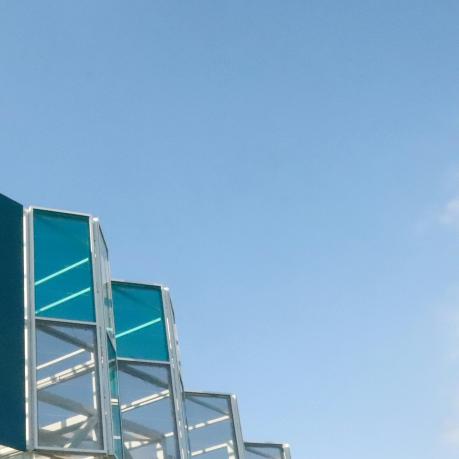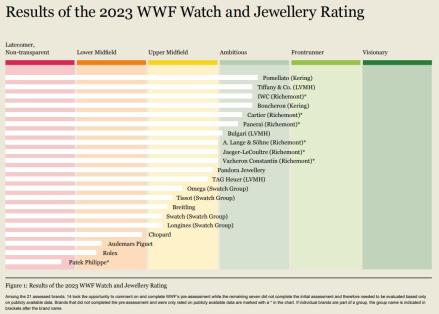
What to look for at COP29: Media Advisory
News publ. 11. Nov 2024
News publ. 10. Nov 2023

Producing luxury good comes at a high price – for the environment and for people involved in the supply chains. With the new Watch and Jewellery Rating 2023, the WWF and adelphi show what companies in the industry have achieved in terms of sustainability and which best practices they should adapt.
Does the watch and jewellery industry shine in terms of sustainability in the same way as its products? The World Wide Fund For Nature (WWF) addressed this question back in 2018 and analysed the sustainability performance of Swiss companies. In 2023, the WWF is now publishing another Watch and Jewellery Rating, in which 21 of the world's best-known luxury watch and jewellery brands are assessed. Spoiler: none of the brands analysed were rated in the two highest categories. The majority were placed in the midfield and some brands such as Tiffany & Co, Boucheron and Cartier were categorised as "ambitious" by the WWF.
Nevertheless, a lot has happened in the industry since 2018 and WWF is endeavouring to involve stakeholders in the search for innovative solutions to protect the environment. With the rating, the foundation wants to show how ambitious companies want to improve the current situation in the industry, what responsible best practices are and how the sector's impact on the environment and human rights can be reduced. To ensure independence, adelphi consult was commissioned to carry out the rating process. The final rating is based on data from publicly available sources and responses from companies to a questionnaire customised for this report.
The importance of this rating should not be underestimated: The extraction and processing of raw materials for the watch and jewellery industry, the operation of production facilities and transport are all associated with significant environmental impacts and social risks. These include air and water pollution, soil degradation, land-use change and deforestation. The use of chemicals is responsible for the destruction of ecosystems and has a huge negative impact on freshwater, forests and wildlife. The extraction and processing of raw materials can be associated with human rights violations such as child and forced labour or land grabbing (WWF 2018).

So how can jewellery and watch companies make their sector more sustainable? In the 2023 Watch and Jewellery Rating Report, WWF and adelphi present some best practices in the areas of sustainability strategy, climate action, biodiversity strategy and water management, human rights management, circular economy, traceability and transparency in supply chains, as well as the monitoring and reporting of sustainability activities and stakeholder engagement. Positive examples of the assessed companies are highlighted as well as innovative new players that work with particularly sustainable business models. Here are some selected highlights:
Most of the brands assessed conduct a double materiality analysis to identify the key issues that form the basis of their sustainability strategies. This should become part of every corporate strategy. In addition, some of the brands assessed have started to restructure their corporate governance and put sustainability management more centre stage. Sustainability should be a key priority on the management agenda and embedded in a transparent governance framework.
The Kering Group has developed a methodology that focuses on measuring and quantifying the environmental impact of its business activities. Data on environmental impacts such as carbon emissions, water consumption, air and water pollution, land use and waste production along the supply chain are converted into monetary values that enable a comparison of the use of natural resources.
While companies are prioritising greenhouse gas emissions accounting and target setting, there is room for improvement in the implementation of comprehensive carbon footprint reduction measures. They need to prioritise the implementation of effective mitigation and reduction strategies along the entire supply chain and align their actions with the principles of the Paris Agreement. They should also commit to ambitious net-zero targets for the years 2025-2030.
A good example of ambitious climate goals is Tiffany & Co. (part of the LVMH Group). The company aims to achieve net-zero greenhouse gas emissions by 2040 and has received external recognition for this goal from the Science Based Targets Initiative (SBTi).
The results of the rating also show that the watch and jewellery sector is lagging behind in identifying and managing biodiversity risks. Water management strategies need to be developed and implemented. When setting contextual targets, companies should follow the hierarchy defined by the Science Based Targets Network (avoid, reduce, regenerate, modify). In all of this, it is important that the watch and jewellery sector works with peers, governments and communities and uses its influence to advocate for nature.
The LVMH Group has started to assess the environmental footprint of its entire value chain. In addition, both the LVMH Group and the Kering Group are among the first companies to work with the Science Based Targets for Nature framework, which aims to align the companies' actions with international biodiversity protection targets.
The end of the product life cycle should be considered right from the product design stage and the reuse of materials should be factored in. Durability and reparability should also be improved. Companies should increase the proportion of recycled raw materials or consider alternative materials. By tapping into the immense potential of the rapidly expanding second-hand markets, watch and jewellery brands can meet the growing consumer demand for more sustainable products.
Swiss watch manufacturer ID Genève (not rated) promotes the use of reused and recycled parts, focusing on the impact of materials at the end of their life cycle. The watches are made from 100 percent recycled stainless steel, refurbished mechanical movements and 100 percent green waste for the straps.
To date, most brands have only a limited understanding of the origin of the raw materials used, the circumstances of their extraction or production and the impact on nature and local communities. There is a need to map the origin of all key raw materials and analyse the social and environmental impacts and risks.
Since 2022, Breitling has been able to trace the origin and path of the raw materials for the "Super Chronomat Automatic 38 Origins" watch with all intermediaries and producers. With the goal of 100 percent diamond traceability by 2025, the Tiffany & Co. brand was already able to trace around 97 percent of individually registered diamonds back to the mines approved by the supplier in 2021.
The report also shows what companies can do to better manage water risks, ensure the protection of human rights in their operations and supply chains, improve the monitoring and reporting of sustainability and human rights activities and promote sustainability across the industry by optimising stakeholder engagement.